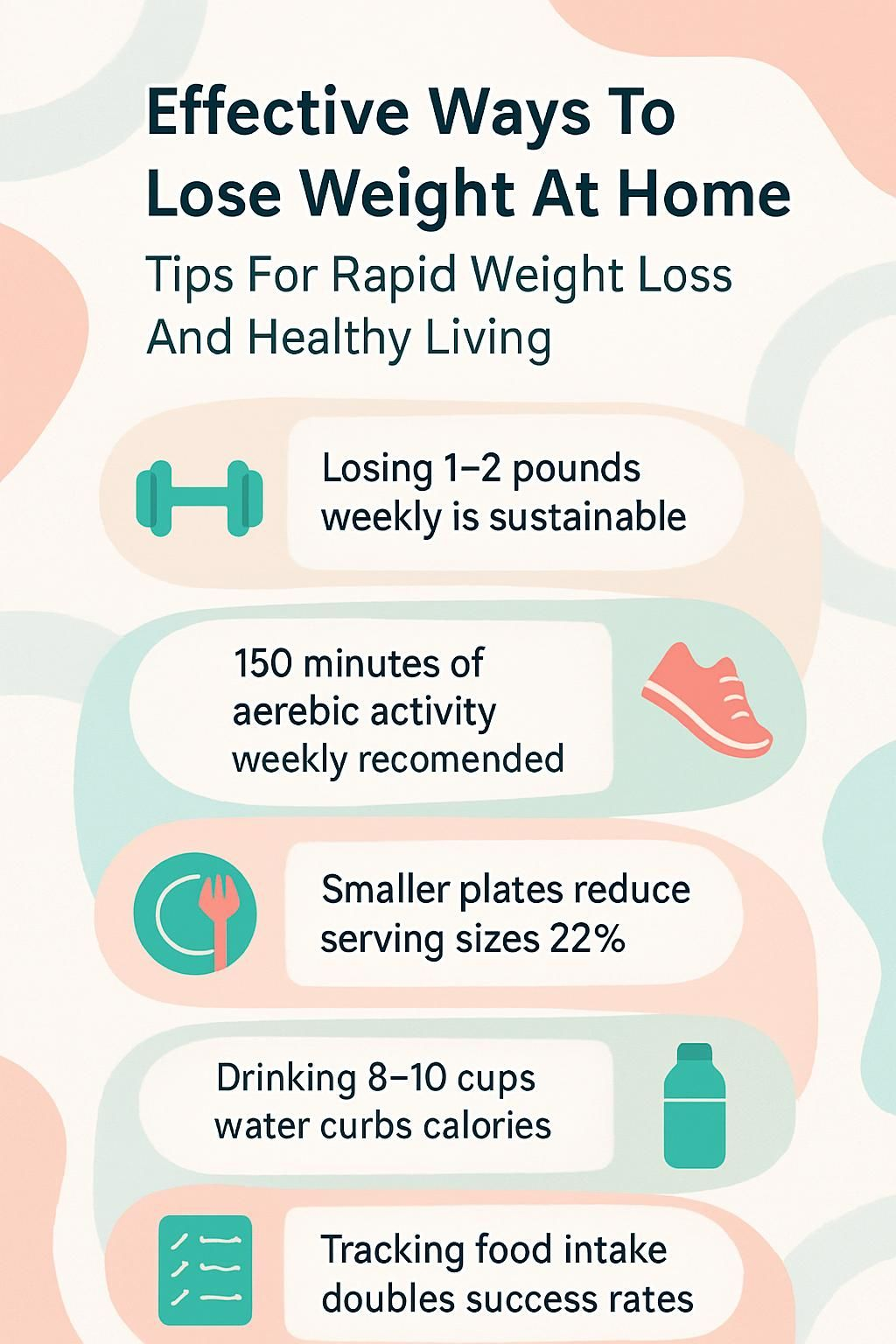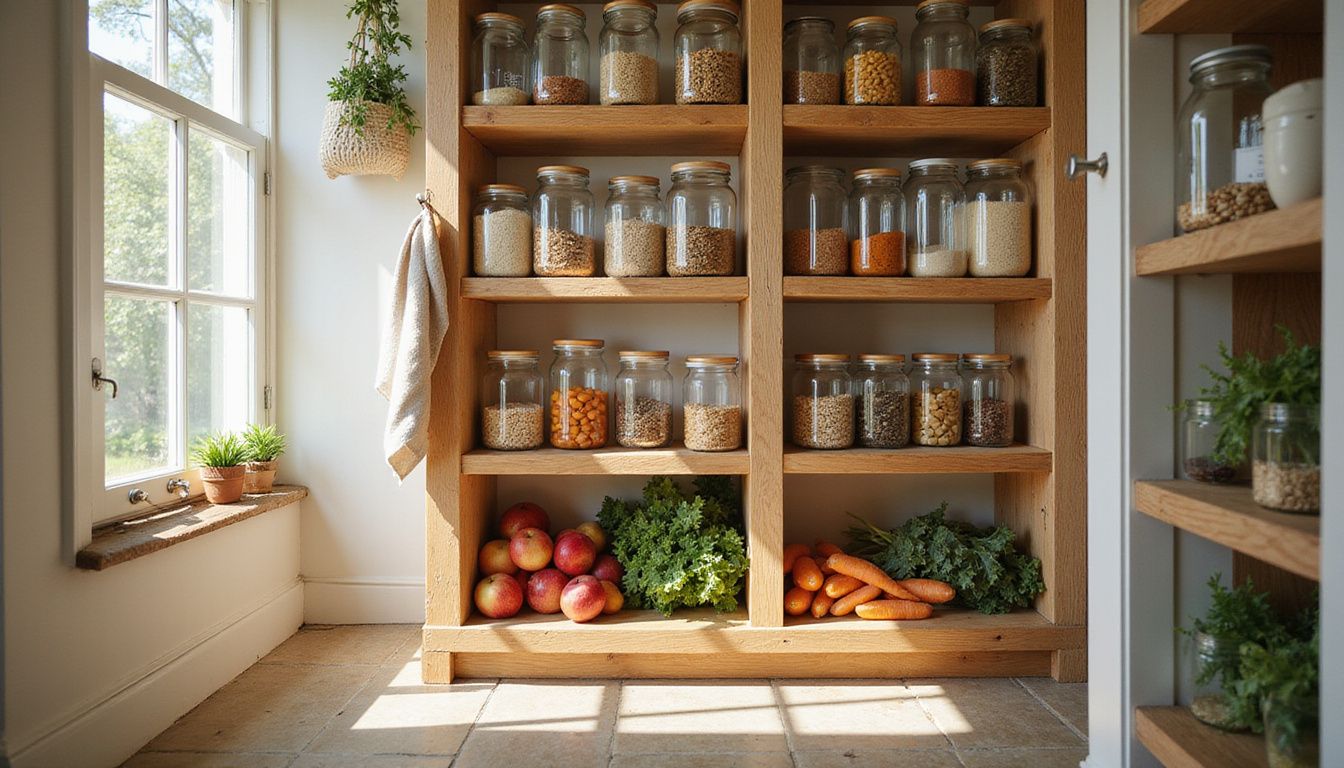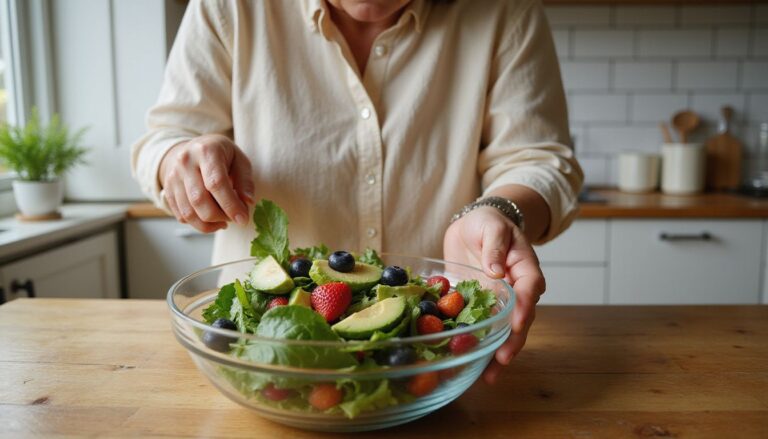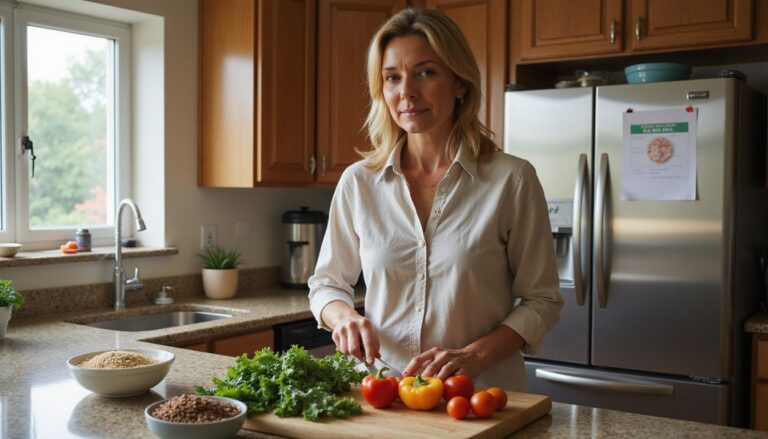Effective Ways To Lose Weight At Home: Tips For Rapid Weight Loss And Healthy Living
Our Nutrition Assistant AI Suite will transform your body. You will lose fat, get toned, and build muscle. Gain confidence and optimal health.
If you feel stuck trying to lose weight at home, you are not alone. A modest pace of 1 to 2 pounds per week lowers your risk of heart disease and type 2 diabetes, according to the Centers for Disease Control and Prevention.
This guide gives practical ways to lose weight with smart diet steps, simple home workouts, and small lifestyle changes. The aim is rapid weight loss that still supports your health. Small moves add up over time.
Key Takeaways
- The CDC notes that losing 1 to 2 pounds per week, created by a daily deficit of 500 to 1,000 calories, supports safe and steady progress.
- Choose nutrient-rich foods such as fruits, vegetables, whole grains, nuts, and lean protein. Limit added sugar to manage hunger and reduce disease risk.
- Accumulate at least 150 minutes of moderate aerobic activity each week, plus two strength sessions, to promote fat loss and protect muscle.
- Drink eight to ten cups of water daily, especially before meals, to help reduce calorie intake. Using smaller plates can cut serving sizes by up to 22 percent.
- Tracking intake with apps like MyFitnessPal or Fitbit is linked to higher success rates in research.

Foundations of Effective Weight Loss at Home

Healthy choices at home set the base for long-term weight management. Start small, pick clear goals, and build habits you can keep.
How do I know if I’m ready to change my lifestyle?
You are ready when commitment beats simple interest. Ask if you can set aside time for meal planning, regular physical activity, and mindful eating each week.
People who keep weight off set specific goals and stay engaged during busy or stressful times. Support from family or friends raises your odds of success.
Stress and time pressure can derail plans. Check if you need extra support, such as help from a health professional, to manage daily stress.
Research shows steady commitment helps people avoid quick fixes like fad diets and maintain progress.
Change happens when the pain of staying the same is greater than the pain of change.
What motivates me to lose weight?
Weight loss lowers risks linked to obesity, including heart disease, high blood pressure, and type 2 diabetes. A high body mass index or a large waist size often prompts action after a medical visit.
The American Heart Association reports that reducing excess fat supports healthier blood vessels and lowers chronic disease risk.
Accountability helps. Write down your goals, track your progress, and share your plan with someone you trust. Short-term targets like 10 pounds before an event can spark action, while long-term goals protect your health.
These motivations push you to follow a healthy diet, build lean muscle through exercise, and limit foods high in added sugar or unhealthy fat.
How can I set achievable weight loss goals?
Aim to lose 1 to 2 pounds per week. Create a daily calorie deficit of 500 to 750 calories to lose weight safely.
Set outcome goals, for example losing 10 pounds or reducing body fat percent. Pair them with action goals, such as walking 30 minutes daily or adding vegetables to lunch and dinner.
Start with a first target of about 5 percent of your body weight. If you weigh 180 pounds, aim to lose nine. This pace supports heart health and long-term maintenance.
Breaking big targets into milestones made success feel doable for me, even after small setbacks.
Nutritional Strategies for Faster Weight Loss
Nutrition drives progress. Smarter food choices help you eat fewer calories and stay full, which supports healthy weight loss.
What is a calorie deficit diet and how do I follow it?
A calorie deficit diet means eating fewer calories than your body uses. Experts suggest a 500 to 1,000 calorie daily deficit for reliable results. A 500 to 750 calorie gap often leads to a 1 to 2 pound drop per week.
Use a calculator to estimate your daily needs based on age, weight, height, and activity. Track intake with a diary or app to keep the numbers honest.
Choose nutrient-dense foods like whole grains, fruits, and vegetables. These support fullness at a lower calorie cost.
Include fiber and lean protein to reduce hunger. Keep snacks simple. Skip sugary drinks and processed treats. Some people find a low-carb or low-fat diet helps them stay on track.
Water or unsweetened drinks reduce calories. I ran a 500 calorie deficit last year and noticed more energy with less bloating. Swapping white bread and rice for whole grains and choosing yogurt over chocolate made a clear difference.
A 500 to 1,000 calorie deficit per day is effective for losing about 1 to 2 pounds weekly.
Why should I focus on whole, nutrient-rich foods?
After setting your calorie target, better food quality speeds progress. Whole, nutrient-rich foods can help you lose weight without exercise on days you cannot work out, since they control hunger and deliver needed vitamins and minerals.
Aim for at least four servings of vegetables and three servings of fruit each day. Whole grains like brown rice and oats offer more fiber than white rice or regular pasta, which helps you stay full and supports digestion.
Plenty of plant foods reduce processed items that are high in sugar, salt, and unhealthy fats; these are linked with weight gain and strain on organs like the liver and pancreas.
Pick low-fat or fat-free dairy to lower saturated fat intake. Whole foods such as produce, nuts, and grains also help reduce risk for cardiovascular disease and prediabetes by supporting steadier blood sugar.
Switching sugary cereal for oatmeal with berries kept me full until lunch. Simple swaps can support long-term weight maintenance and steady energy.
How can I reduce processed and high-sugar foods in my diet?
Read nutrition labels before you buy. Many processed foods hide trans fats, added sugars, and excess salt, which slow your progress.
Swap desserts and soda for whole fruit. Natural sugars in fruit come with fiber and water, which blunt spikes in blood sugar compared with packaged sweets.
Do not keep trigger foods at home. Stock quick options like air-popped popcorn, fresh fruit, or plain rice cakes.
Some low-fat items load up on sugar for flavor. Check the label for added sugar even if the front looks healthy.
Replacing candy bars with apples and unsweetened nut butter helped me lose 10 pounds over three months and cut my cravings.
What high-fiber foods help me feel full longer?
Choose oats, brown rice, and whole wheat bread over white bread or refined grains. Beans, lentils, and chickpeas are rich in fiber and protein. A cup of cooked lentils has about 15 grams of fiber.
Fruits like apples and pears with skin, oranges, and berries raise your fiber intake while meeting carb needs. Vegetables such as broccoli, carrots, artichokes, and Brussels sprouts increase fullness and may reduce belly fat over time.
Nuts add healthy fat and fiber that manage hunger. Glucomannan, a fiber from the konjac plant, can expand in the stomach and slow digestion, which may support weight loss[1].
Shifting to these foods helped me stop overeating during stressful weeks. For even better control, learn simple ways to size portions.
…
[1] Source: “The effect of glucomannan on body weight,” systematic review & meta-analysis published June 2020
How do I manage food portions effectively?
Simple steps can help you control portions and maintain a calorie deficit without feeling deprived.
- Use smaller plates to make portions look larger. Research from Cornell University suggests this can cut intake by up to 22 percent.
- Measure high-calorie foods like nuts, oils, and protein powders with a scale or cups.
- Serve food in the kitchen, not at the table, to reduce second helpings and mindless eating.
- Practice mindful eating. Sit down, slow your pace, and set the fork down between bites.
- Stop when satisfied. Save leftovers for later rather than finishing out of habit.
- Limit distractions during meals. Eating without screens may reduce intake by up to a quarter.
- Fill plates with fiber-rich foods like fruits, vegetables, and whole grains to increase fullness.
- Drink water before and during meals to gently reduce hunger and replace sugary drinks.
- Meal prep and pre-portion snacks in clear containers to avoid impulsive eating.
- Work with a registered dietitian for personalized portion guidelines if needed.
- Track portions in an app or food log to spot patterns and build awareness.
A month with a food scale helped me eat less and feel less bloated. I lost 5 pounds without feeling restricted.
Home Workouts for Rapid Weight Loss
Regular home workouts help you burn calories and reshape body composition. Think of movement as a daily deposit in your health bank.
How often should I exercise at home for weight loss?
Aim for at least 150 minutes of moderate aerobic exercise or 75 minutes of vigorous activity each week. Many people do 30 to 60 minutes on most days for quicker progress.
Add strength training two to three times per week to preserve muscle while you lose fat. More muscle raises your resting metabolism, which makes weight control easier.
Some people need more activity to lose weight quickly or maintain results. Daily movement like stair climbing or short high-intensity intervals can help reduce deep belly fat.
Notice how your body responds, then adjust your plan to meet your goals without burning out.
What are the best bodyweight exercises for losing weight?
Bodyweight moves require no gear and target major muscle groups. Combine several for a balanced routine.
- Push-ups: Work your chest, arms, and shoulders. Engaging many muscles increases calorie burn.
- Squats: Train thighs, hips, and glutes. They raise heart rate and build lower body strength.
- Lunges: Strengthen legs and glutes while improving balance and total muscle use.
- Planks: Build core, shoulder, and back strength. A strong core makes other moves safer.
- Burpees: Blend a squat, jump, and push-up for cardio and strength in one sequence.
- Mountain climbers: Elevate heart rate quickly while working arms and legs.
- Calisthenics routine: Rotate push-ups, squats, planks, and more at least twice a week.
- High knees: Jog in place with knees high to boost metabolism and stamina.
Daily squats and planks helped me see early gains in three weeks. Simple moves can deliver real progress at home.
Which cardio routines can I do at home?
Cardio raises heart rate and burns calories. Choose activities that fit your space and fitness level.
- Walk briskly for 30 minutes indoors or outside to ease stress and lift energy.
- Dance along with free NHS Fitness Studio videos or your favorite playlist.
- Do circuits like jumping jacks, high knees, and mountain climbers for 10 to 20 minutes.
- Use a stationary bike for 20 to 40 minutes per session to improve endurance.
- Swim laps or try water aerobics if you have pool access to protect your joints.
- Follow free online cardio, HIIT, and yoga sessions from trusted sources, including the NHS.
- Set a daily step goal using a fitness app to encourage more movement.
- March or jog in place during TV breaks to add short bursts of activity.
- Climb stairs for at least 10 minutes to boost metabolism and leg strength.
- Use a jump rope for a fast, high-intensity workout in a small space.
- Mix different cardio sessions during the week to stay engaged and challenge all muscles.
How does resistance training help build muscle and lose weight?
Resistance training uses weights or bands to build lean muscle. Muscle burns more calories at rest than fat does.
Johns Hopkins research links strength work with preserved muscle during weight loss and higher daily energy burn. That means an easier time maintaining a healthy weight.
Do resistance exercises at least twice a week. Bodyweight squats and push-ups at home can drive real gains. Combine strength with cardio for faster fat loss and stronger health.
Lifestyle Adjustments for Sustained Healthy Living
Daily habits shape your results. Think of sleep, stress control, and hydration as the quiet drivers of change.
How much sleep do I need for optimal metabolism?
Most adults need 7 to 9 hours of sleep each night to support a healthy metabolism. Too little sleep disrupts hormones that manage hunger and fullness.
Sleep affects how your body uses energy and processes nutrients. People who sleep well tend to lose weight more easily and keep it off.
Regular physical activity improves sleep quality, and better sleep gives you energy for workouts. Make sleep a core part of your plan.
What are effective yoga or meditation techniques to reduce stress?
Lowering stress can reduce emotional eating and support steady weight loss. Guided options make it easier to begin.
- Try beginner NHS yoga videos to learn basic poses and breathing.
- Practice diaphragmatic breathing for five minutes a day to calm your nervous system.
- Use guided meditation apps like Calm or Headspace for short daily sessions.
- Do a body scan before bed to relax muscles and improve sleep.
- Eat mindfully at meals. Focus on taste, texture, and quality to slow down.
- Use Child’s Pose or Cat-Cow to ease back tension and promote digestion.
- Drink water after yoga or meditation to rehydrate without sugary drinks.
- Journal after sessions to note gratitude and spot craving triggers.
- Join live-streamed classes for social support and real-time feedback.
Explore simple cardio and resistance workouts at home to boost your plan.
How much water should I drink daily for weight loss?
Aim for about 8 to 10 cups of water daily, roughly 64 to 80 ounces. Drinking water supports your body’s functions and may reduce hunger.
People who drink water before meals often eat fewer calories in those meals. Replace sugary drinks with water, and add lemon or lime for flavor.
Carrying a reusable bottle helped me stay hydrated and lowered snack cravings. The CDC also encourages choosing water to support healthy weight management.
What are mindful eating practices and how do I adopt them?
Mindful eating builds awareness of hunger and fullness cues. These steps keep portions reasonable and limit overeating.
- Eat without TV or phones so you notice when you are satisfied.
- Chew slowly, aiming for about 20 chews per bite to reduce intake.
- Choose whole foods like vegetables, fruit, lean meats, and nuts over ultra-processed snacks.
- Use smaller plates and bowls to keep portions in check.
- Drink a glass of water before meals to support metabolism and cut false hunger.
- Pause between bites. Give your stomach time to signal fullness.
- Observe how foods make you feel. Nuts often give steadier energy than sugary treats.
- Keep a regular meal schedule. Skipping meals can lead to overeating later.
- Stop before you feel stuffed. Fullness signals take about 20 minutes to register.
- Practice gratitude. It strengthens awareness and supports healthy choices.
Pair these habits with strength and cardio sessions for better results.
Advanced Techniques for Weight Loss
Advanced methods can speed progress if your basics are in place. Choose options that fit your lifestyle and medical needs.
Why should I reduce refined carbs and sugars?
Cutting refined carbs and added sugars helps reduce belly fat. These foods spike blood sugar, which encourages fat storage, especially in the belly.
Choosing whole foods helps your body work efficiently and lowers long-term disease risk. In a 2019 study, adults who cut sugary snacks lost up to 6 percent more body fat in three months than those who did not.
Try replacing refined grains with beans, nuts, fruits, and vegetables. I used to grab processed bars and felt tired soon after. Switching to a handful of nuts or fruit cut my cravings.
What are the benefits of intermittent fasting?
Reducing refined carbs stabilizes blood sugar. Intermittent fasting can add another layer by leaving longer gaps between meals, which may help your body use stored fat.
Research suggests fasting windows can lower insulin levels and improve heart health markers. A 2019 review in the New England Journal of Medicine reported benefits for fat burning and metabolic health.
Many people notice clearer thinking during short fasts. Include water and nutrient-rich meals with produce, lean protein, and healthy fats during eating periods for balance.
Which metabolism-boosting beverages aid weight loss?
Hydrating wisely supports appetite control and metabolism. Replace sugary drinks with options that may offer a small metabolic lift.
- Water supports every body system and daily calorie burn. A common target is eight 8-ounce glasses a day.
- Cold water may raise calorie burn slightly as your body warms it.
- Green tea contains compounds linked with higher fat burning for short periods.
- Black coffee can raise metabolism for a short time. Skip added sugar and cream.
- Herbal teas like peppermint or ginger may help with hydration and appetite control.
- Infused water with citrus or cucumber adds flavor without extra calories.
- Swapping soda and juice for water can trim hundreds of calories per day, which supports weight loss.
Staying hydrated helps manage hunger and keeps you on track with your goals.
How do high-protein foods support weight loss?
Protein helps you feel full longer and uses more energy to digest compared with carbs or fat. This is known as the thermic effect of food.
Lean meats, eggs, dairy, beans, and nuts support muscles during calorie cuts. A Johns Hopkins analysis reported faster weight loss with higher protein intake while maintaining lean tissue.
Replacing chips with roasted nuts and adding grilled chicken to salads helped me snack less. Protein steadies appetite so you are less tempted by sugary snacks.
How can using smaller plates help control portions?
After boosting protein to control hunger, plate size is a simple next step. Using smaller plates reduces self-served portions without feeling deprived.
Research in the International Journal of Obesity found that dropping plate size from 12 inches to 10 inches led people to serve up to 22 percent less food.
On a large plate, a modest serving looks tiny, which nudges you to add more. A 9-inch plate made it easier for me to stick to healthy amounts and maintain a calorie deficit.
Tools and Resources for Weight Loss Success
Digital tools make it easier to track food, plan workouts, and build daily habits. Use them to see patterns and stay consistent.
How do I keep a detailed food and exercise log?
Logging food and activity improves accuracy and accountability. Consistent journaling has been linked with higher weight loss success rates¹.
- Write down every meal, snack, and drink. Include items like nuts or organ meats if you eat them.
- Add estimated calories for each item. Use verified apps such as MyFitnessPal or Fitbit.
- Log workouts with type, duration, and estimated calories burned.
- Note the time of eating and activity to spot triggers, like late-night snacking.
- Record mood or hunger level to find patterns behind overeating.
- Include key nutrients such as fiber, protein, and added sugar when possible.
- Review your log weekly to catch trends and set small course corrections.
- Set daily goals, for example three servings of fruit or eight cups of water, and check them off.
- Keep your log private if that helps honesty and consistency.
- Update entries right after meals or exercise for accuracy.
¹ Kaiser Permanente study, 2008: Keeping a food diary can double weight loss results.
What are the best fitness apps and workout videos for home use?
Tracking tools help you measure progress. These options make home fitness easier and more engaging.
- NHS Fitness Studio: Over 60 free videos including dance, yoga, and Pilates for all levels.
- MyFitnessPal: Tracks calories, nutrition, and exercise with a large food database.
- Nike Training Club: Free bodyweight workouts from 5 to 50 minutes for strength and mobility.
- Fitbit App: Pairs with wearables to monitor steps, heart rate, and sleep while logging food.
- YouTube, for example FitnessBlender: Hundreds of full-length workouts that need little or no equipment.
- Daily Yoga: Guided sessions to build flexibility and reduce stress.
- Mayo Clinic: Newsletters and resources with expert health and exercise tips.
- FitOn: On-demand classes for cardio, strength, HIIT, and guided meditation.
Use what you enjoy. Consistency matters more than the perfect program.
How can meal planning apps improve my diet?
Meal planning apps remove guesswork. They help you shop, prep, and hit your targets without last-minute stress.
- Plan weekly menus to avoid fast food. The NHS Healthier Families site lists 100 plus recipes you can filter by ingredient or time.
- See nutrition facts for each meal, including calories, protein, fiber, and sugars.
- Get suggested serving sizes to support portion control.
- Use auto-generated shopping lists to buy only what you need.
- Turn on water reminders to support hydration and appetite control.
- Enter your calorie target for weight loss and let the app suggest meals that fit.
- Track choices over time to swap high-sugar or high-fat items for fiber-rich foods.
- Sync with fitness trackers to match intake with activity.
- Keeping nuts and fresh fruit on my plan made snack time simple and healthier.
- Apps remove the nightly “what’s for dinner” struggle and keep routines steady.
Overcoming Weight Loss Challenges
Every plan hits bumps. Expect challenges and use simple tactics to keep moving forward.
How can I overcome weight loss plateaus?
Plateaus are common. Your body adapts to your routine, so small adjustments help.
Trim calories in small steps or add new exercises such as resistance work or extra cardio. Track energy, sleep, and hunger to guide changes.
Use more than the scale. Check how your clothes fit or measure your waist. A waist under 35 inches for many women and under 40 inches for many men points to progress.
Shifting my workouts and meal timing helped me break a stall last year. Small tweaks made a big difference.
What strategies help me stay motivated through setbacks?
Motivation rises and falls. Build systems that keep you going on tough days.
- Set small, clear goals and celebrate modest wins each week.
- Lean on a support network of friends, family, or online groups.
- Post reminders of your “why” in places you see daily.
- Reward healthy actions with non-food treats like a new playlist or book.
- Review setbacks without blame. Adjust the plan and continue.
- Rotate workouts to reduce boredom, for example alternate strength and cardio days.
- Track non-scale wins like better sleep and higher energy.
- Keep nutrient-dense snacks visible to support better choices.
- Mark milestones in a private log. It kept me positive during hard weeks.
How do I manage and reduce food cravings?
Cravings are normal. A few simple habits can reduce how often they hit and how strong they feel.
- Do not stock chips, cookies, or candy at home. Easy access fuels overeating.
- Pick smarter snacks such as air-popped popcorn, fresh fruit, or a handful of nuts.
- Drink water before meals. It can ease hunger and support hydration.
- Eat on a schedule to prevent extreme hunger later.
- Center meals on vegetables, lean protein, and fruit for steady energy.
- Practice mindful eating. Slower chewing helped me feel satisfied with less.
- Distract yourself with a short walk or a call when a craving hits. Many fade in 15 to 20 minutes.
- Keep a food log to find triggers and plan around them.
- Include high-fiber foods like apples, oats, or nuts to stay full longer.
- Sleep 7 to 8 hours. Poor sleep raises hunger hormones.
- Lower stress with yoga or meditation. High stress can increase sugar cravings.
These steps give you more control and support rapid weight loss while protecting your health.
Strategies for Long-Term Weight Maintenance
Maintenance depends on steady habits and realistic choices. Think of it as practicing the basics well, day after day.
Why is prioritizing lifestyle over quick fixes important?
Fad diets promise fast results but often lead to regain within one to five years. Gentle changes stick better and protect your health.
Adding high-fiber foods like nuts and vegetables supports steady progress. A very restrictive plan helped me lose weight fast once, then I regained it. Sustainable habits worked much better.
Choose slow, durable shifts instead of short-term extremes. Your body adapts, and you maintain results longer.
How do I create a consistent exercise routine?
Set a weekly schedule and treat workouts like appointments. Aim for at least 150 minutes of activity each week.
Do strength training twice weekly to protect muscle and support metabolism. Pick activities you enjoy so you stick with them.
Create simple goals for each session. For instance, do squats and push-ups every Monday and Friday. Track progress to see improvements.
If staying consistent is tough, invite a friend to join you. Support makes it easier to show up.
How can I build a support network focused on health?
Support improves accountability and encourages better choices. Build your circle with people and tools that help.
- Join online health communities to connect with people who share your goals.
- Invite friends or family to cook healthy recipes or exercise with you.
- Self-refer to weight management services for faster access to help.
- Attend virtual classes that teach meal prep and practical home workouts.
- Share updates in group chats or forums to stay accountable and celebrate wins.
- Find a workout buddy from your school, job, or neighborhood.
- Use apps with community features for feedback on nutrition and activity.
- Join local walking groups or community nutrition clubs.
- Pick groups that match your interests, such as high-fiber cooking or plant-forward eating.
- Consult dietitians or certified trainers for structured guidance and regular check-ins.
Conclusion
Effective weight loss at home starts with clear goals and small, steady habits. Eat more fruits, vegetables, whole grains, and nuts, and limit foods high in added sugar.
Exercise at least 150 minutes each week. Mix cardio with strength training. Aim for a 1 to 2 pound loss weekly and track progress with a simple food and activity log.
Use trusted tools and free resources to stay consistent. Choose water over sugary drinks and check labels to cut extra calories. Seek medical advice if you have a condition like diabetes or heart disease, or if you are unsure about diet changes.
Small daily choices lead to big results. Healthy living grows with each step you take at home.
FAQs
1. How do organs in the body help with weight loss at home?
Organs such as the liver and muscles play a key role in burning calories and processing nutrients. The liver helps break down fats, while muscles use energy during exercise. Studies show that regular physical activity increases muscle mass, which can boost metabolism and support rapid weight loss. For example, after adding daily walks and light strength training at home, I noticed improved energy and steady weight loss over several weeks.
2. Can eating nuts as a fruit help with healthy living and weight loss?
Nuts, classified as fruits, provide healthy fats, protein, and fiber. Research from the Harvard School of Public Health found that people who eat nuts regularly have a lower risk of obesity. A small handful of almonds or walnuts can help control hunger and support a balanced diet. I often choose nuts as a snack, which keeps me full and reduces cravings for less healthy foods.
3. What evidence-based tips support rapid weight loss at home?
Effective methods include tracking calorie intake, increasing water consumption, and choosing nutrient-rich foods like vegetables, lean proteins, and nuts. The National Institutes of Health recommends at least 150 minutes of moderate exercise each week for weight management. Keeping a food journal and planning meals can also help maintain healthy habits.
4. How do organs and nuts work together to support healthy living?
Organs such as the digestive system process nutrients from foods like nuts, which are rich in vitamins, minerals, and antioxidants. These nutrients support organ function, boost metabolism, and improve overall health. Eating a variety of fruits, including nuts, helps the body function well during weight loss efforts.
Summary: Organs play a central role in metabolism, while nuts as fruits offer key nutrients for hunger control and health. Evidence-based strategies such as regular exercise, mindful eating, and nutrient-rich foods support rapid weight loss and lasting wellness at home.







